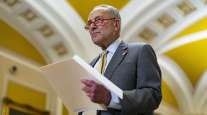Obama Devotes $73.61 Billion to Surface Transport in Budget
This story appears in the March 10 print edition of Transport Topics.
President Obama’s fiscal 2015 budget proposal includes $73.61 billion for surface transportation, a 1.8% increase over this year’s level, as part of an overall $302.3 billion transportation plan in the next four years.
Transportation Secretary Anthony Foxx said during a March 4 press briefing that increasing freight-movement capacity is one of his four main priorities, and the budget includes a new $10 billion fund dedicated to rail, highway and port projects over four years.
“We’ve been talking for months, if not years, about a critical deficit that is undermining our ability to grow our economy, undermining our ability to get where we need to go, and undermining our safety: America’s infrastructure deficit,” Foxx said.
DOT’s budget includes $668.5 million for the Federal Motor Carrier Safety Administration.
Obama’s general budget message also mentioned infrastructure.
“There is clearly much more we can and should do to invest in areas like infrastructure, innovation and education that will create jobs, economic growth and opportunity,” Obama said.
The surface transportation reauthorization legislation is what House and Senate members are working on now to replace the MAP-21 plan that expires Sept. 30. The total request for all of the U.S. Department of Transportation in fiscal 2015 is $90.92 billion.
As for how to pay for this and other transportation spending, Foxx said the administration is sticking with its proposal to use $150 billion from corporate tax reform as a four-year fix. Foxx has been saying since January that the Highway Trust Fund could go broke in August.
American Trucking Associations criticized the proposal.
“Today’s proposed budget misses the mark when it comes to the transportation needs of the U.S. economy,” ATA President Bill Graves said. “It provides no real funding solutions for the long-term health of our infrastructure and proposes massive new subsidies for a mode that moves a small proportion of America’s freight and passengers,” a reference to rail transportation.
Added ATA Chairman Philip Byrd Sr., president of Bulldog Hiway Express, “Using the proceeds from corporate tax reform, while creative, does little to address the long-term solvency of the Highway Trust Fund or to uphold the principle of users paying for the services they get — in this case, the federal fuel tax, which has not been adjusted in more than two decades to account for inflation and improvements in vehicle fuel efficiency.”
The resort to transition revenue from tax reform means the administration is “giving up on user-based transportation funding,” said Joshua Schank, president of the Eno Center for Transportation, a nonpartisan policy research group.
Schank said a durable, long-term decision needs to be made on how to fund federal transportation needs. User fees have been the dominant choice until recently.
Four years of transition funding, though, just postpones a real decision, he added.
The transportation budget also recommends increasing authority for grants made by DOT. The TIGER program — Transportation Investment Generating Economic Recovery — currently is authorized for $600 million a year, but the budget calls for it to more than double to $1.25 billion a year.
The Transportation Infrastructure Finance and Innovation Act grants, or TIFIA, would be funded at $1 billion a year and be moved into the transportation secretary’s office from FHWA.




